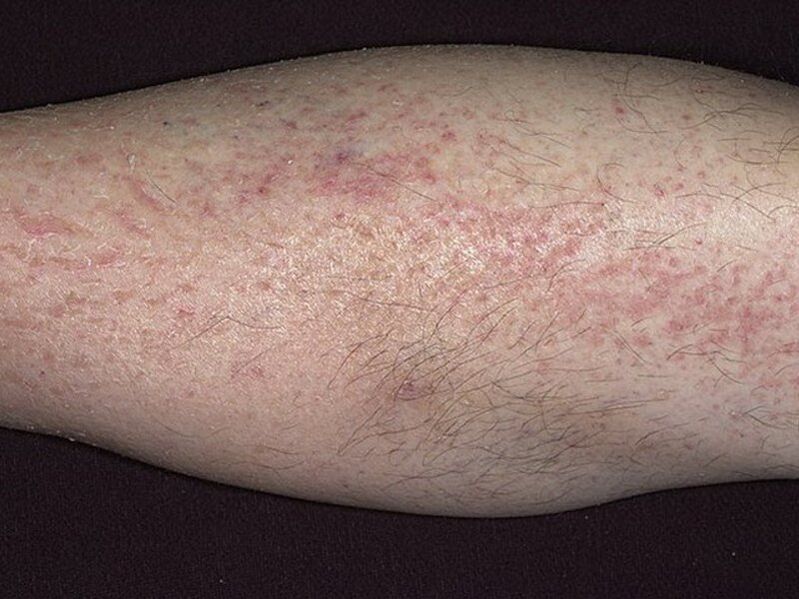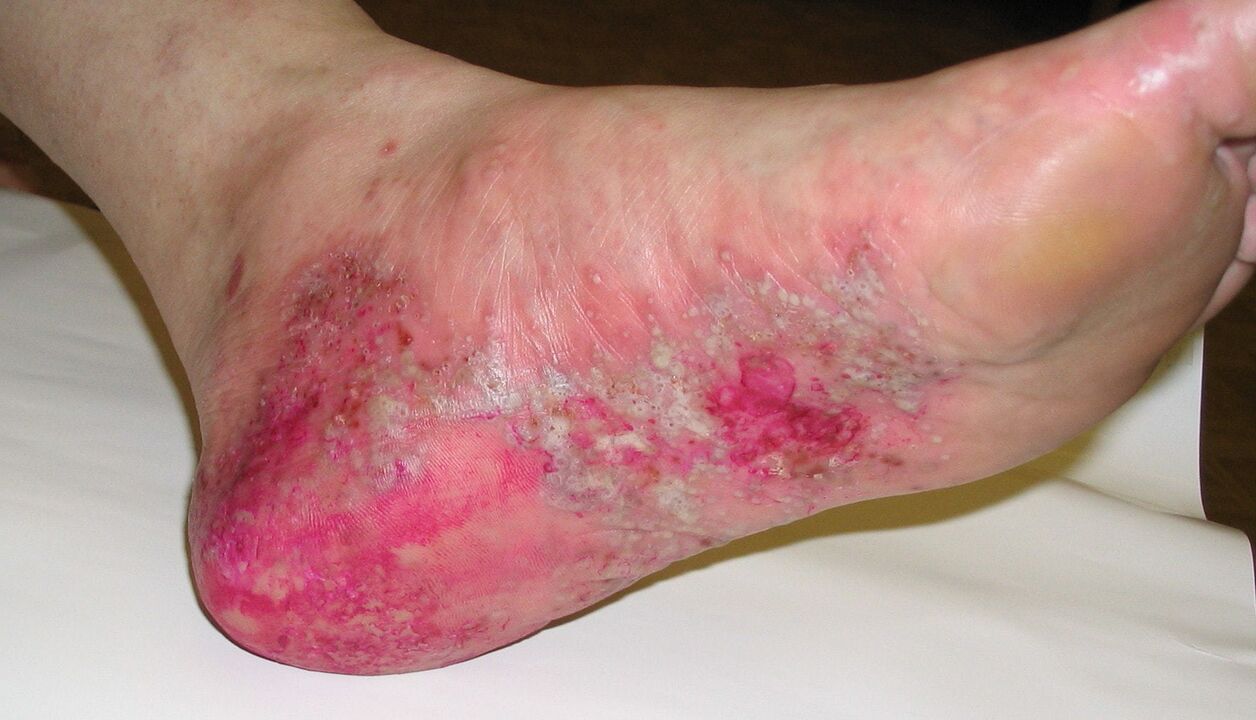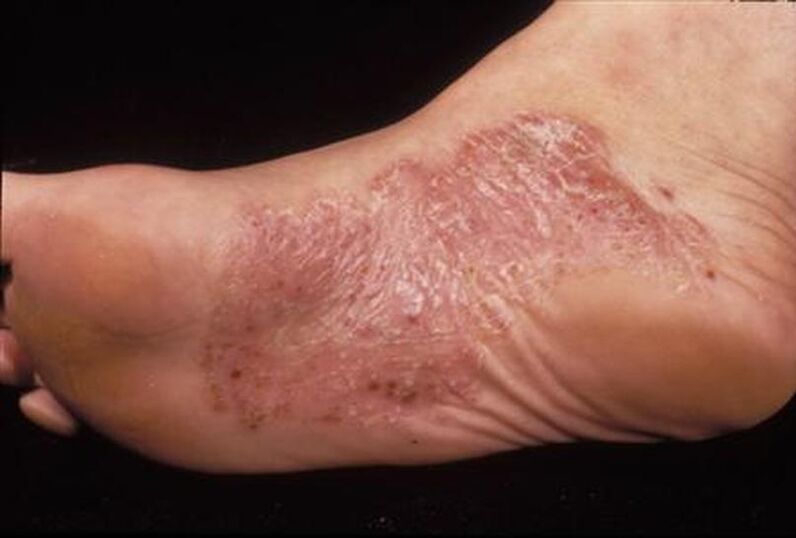
Since the exact etiology of the process is unknown, the search for the most effective treatment is relevant. Hormonal drugs are often used to treat the disease, which only alleviate external symptoms, while remission lasts for several months, and the drugs themselves can cause side effects. Remedy for psoriasis on the feet is prescribed by a dermatologist, while a complex of traditional methods may include folk remedies for psoriasis.
There are many ways to treat psoriasis on the feet. As a rule, treatment of foot psoriasis includes systemic and local therapy, appointment of physiotherapy, adherence to diet and nutrition.
Classification of psoriasis of the lower extremities
On the feet, psoriasis manifests itself in only 30% of cases of skin lesions. Dermatologists classify the initial stage of disease development in this part of the body into two groups:
- Psoriasis type 1. It affects the legs of children, adolescents, adult men and women due to their genetic predisposition to this disease. In total, at least 60% of all cases had relatives who suffered from this disease. Psoriasis of the lower extremities is most often transmitted to offspring born in 3. -4. The treatment of hereditary psoriasis is long and requires the systemic application of special drugs that prevent the spread of plaques from the surface of the legs to the trunk and other parts of the body.
- Psoriasis type 2. This is an already acquired form of the disease, which develops due to the presence of the above-mentioned risk factors. The age category of patients with foot psoriasis are people who have reached the age of 40 and over. Often these dermatological patients abuse alcohol, eat unhealthy food, work in companies with harmful working conditions or have experienced a morally difficult stressful situation in their lives. In such patients, the initial stage of the disease is always acute and with a vivid clinical picture. A month after the appearance of the first red spots, the affected knee and hip joints begin. It all depends on the location of the plaques.
Prevention
The fact that the disease is much easier to prevent than to cure is no secret.
This statement is completely true for psoriasis. To prevent the development of psoriasis, the following recommendations should be followed:
- avoid emotional tension and stress. Have a positive attitude towards life, don’t worry about the little things;
- lead a healthy lifestyle, do not abuse alcohol, smoke and, moreover, never use drugs;
- timely treat foci of infections in the body, strengthen general immunity;
- lubricate the skin with moisturizers, prevent dehydration and dryness;
- do not neglect such effective means of prevention as folk. Sometimes it is enough to apply allergic herbal creams with appropriate herbal creams so that the diagnosis of psoriasis is never heard.
Affected skin care
If there are plaques and rashes on the feet, they should be smeared with special preparations with moisturizing ingredients. It is good if the composition includes both anti-inflammatory and immunostimulating substances.
Do not lubricate the affected areas of the skin with aggressive products that contain high concentrations of alcohol. The skin should not be dehydrated.
Special care should be taken to avoid injuries and damage to the skin. They are reliably known to cause new rashes, which are not easy to cure. It is worth using only soft, non-traumatic bath accessories.

Diet
Proper nutrition is not of little importance. Often, dietary violations recommended by a doctor do not allow the treatment of psoriasis for many years.
Alkaline foods in the diet should be two to three times more than acidic. Alkaline foods include non-acidic fruits and vegetables. Alkaline mineral water can help. You should monitor the timely emptying of the intestines, use products that improve peristalsis
Complications
Complications in psoriasis are characterized by the appearance of concomitant diseases. The cardiovascular system suffers the most, often leading to heart attack or coronary heart disease. In some cases, the disease can cause diabetes.
Treating psoriasis on the fingers requires an integrated approach and, most importantly, time. Therapeutic actions should primarily be aimed at reducing the focus of inflammation. Psoriasis on the hands often spreads to the nails, which should not be allowed. Otherwise, the healing will take much longer.
Treatment
Treatment must be complex, and medications must be different. Be sure to use:
- Creams and ointments.
- Antihistamines.
- Medicines for the gastrointestinal tract.
- Immunosuppressants.
This is a basic treatment that always helps with mild stages of psoriasis.
Physiotherapy
Physiotherapy is used as one of the stages in the treatment of psoriasis. These procedures are based on the use of various natural factors, so they help stop the course of the disease. The patient undergoes a course of infrared and ultraviolet radiation, acupuncture and cryotherapy.
Folk methods
Traditional medicine abounds with recipes for eliminating the symptoms of the disease and achieving long-term remission. First of all, various baths have worked well:
- with sea salt;
- with herbal decoctions.
Bay leaf baths are effective. For cooking, pour 20 gr. leaves with 2 cups water and cook for 10 minutes on low heat. After the soup has cooled, you must keep the affected hands or feet in it for at least half an hour.
Skin on the hands or feet affected by psoriasis can be wiped with juniper tincture, birch tar or celandine juice. Cranberry oil is advised to lubricate nails to strengthen them.
What does psoriasis on the legs look like?

The initial form of the disease does not cause serious discomfort to the patient. It is manifested by mild itching and redness of the skin. Gradually, the intensity increases and plaques of pink or red hue appear on the legs. The size of the papules is in the range of 3-5 mm, with further development, the spots grow and merge with each other.
Characteristic manifestations are yellowish or white scales, they are easily scraped, but peeling increases in this case. If you get rid of peeling, you can see the red glossy film. Its removal causes the release of drops of blood, which in medicine is called blood dew.
Psoriasis forms on the soles, followed by unbearable itching. Patients cannot resist the urge to comb the affected area. This opens up access to a bacterial infection, making further treatment difficult.
Why psoriasis develops on the legs
Psoriasis of the feet is a chronic skin pathology with a hereditary predisposition. The development of the disease is facilitated by the influence of predisposing factors. Factors that predispose to psoriasis of the feet:
- Limb injuries - scratches, cracks, wounds. In people prone to this pathology, they often become inflamed, accompanied by itching and scratching. Against this background, psoriatic rashes appear. These causes most commonly cause psoriasis in the knee joints in children, adolescents and athletes.
- Skin diseases and scratches on the feet. The disease especially often develops against the background of fungal infections. It is important to wear tight shoes in which your feet sweat and hurt.
- Metabolic disorders, obesity, diabetes mellitus, endocrine diseases, age-related hormonal disorders, pregnancy. Any hormonal imbalance can cause disease.
- Any chronic processes and foci of infection lead to intoxication of the body.
- High emotional, mental and physical stress.
- Improper diet, intestinal dysbacteriosis.
- Immune disorders.
Treatment with folk remedies
Very often the treatment of foot psoriasis is not limited to traditional medicine. It is better to join forces with recipes for effective traditional medicine.
The recipe for decoctions, ointments, baths, compresses is most often used to solve psoriasis.
Decoctions
To prepare a remedy that can alleviate the acute symptoms of the disease, you will need celandine and oregano, take in equal proportions, add chopped licorice root, which should be 2 times more than each of the previous components, and take three times more wire. All this mixture should be poured over boiling water and kept for a quarter of an hour. Then strain the infusion and take half a glass twice a day. Maximum effectiveness can be achieved if psoriasis is just beginning to appear.
Mast
Birch tar is mixed with olive oil, and the resulting mixture is applied to the plaques as often as possible to achieve maximum effect.
Baths
For these purposes, an infusion of celandine is suitable, not only will help remove the rash, but will also normalize the functioning of the body.
Celandine is poured over boiling water, insist for at least an hour, filtered and added to a warm bath. The process of bathing with celandine should not take longer than 10 minutes. This method can become commonplace.
Compresses
The potatoes went well here. To prepare the dressing, you will need to grate the raw potatoes on the smallest grater. Then the juice is squeezed from the obtained mass and applied to the affected areas, the leg is wrapped with a film or bag from above and a warm sock is put on. Potato compression lasts for several hours, otherwise the effect will not be achieved.
Characteristics of rash
The clinical picture of foot psoriasis is manifested depending on the course of the disease, ie its stage.
There are the following stages of psoriasis:
- Initial. The rash at the very beginning of the disease looks like acne, slightly convex in shape. In addition, silver-steel scales begin to form on each papule;
- Progressive. The rash appears more and more, and the papules begin to increase in diameter and merge, forming a continuous area of damage. This whole process is accompanied by intense unbearable itching;
- Acute. The disease, which enters the phase of acute development, is accompanied by a new rash, while the old ones stop growing, the process of peeling begins;
- Stationary. New elements of the rash no longer appear, and the affected areas of the skin completely peel off. A pigmentation zone forms at the site of previous plaques;
- Regression. At this stage, the disease is characterized by cleansing the skin of signs of psoriasis, the general condition of the patient is greatly improved.
Treatment and diagnosis
Diagnosis and treatment of psoriasis on the feet is performed by a dermatologist, the method is very simple and consists of a simple examination of the skin, blood tests (general and biochemical). Modern medicine does not have the means to completely cure psoriasis. In some cases, treatment is used to alleviate the condition and remission the symptoms.
It depends on many factors such as:
- gender of the patient;
- age range;
- place of residence (climate zone);
- activities (work, etc. );
- stage of psoriatic lesions.
Treatment with topical medications
In addition to products that hydrate the skin, a dermatologist may prescribe the use of local preparations that are easy to use at home:
- agents containing charcoal tar, help slow the growth of psoriatic plaques and keratinized scales.
- salicylic acid solution allows you to remove and peel the shell with great efficiency;
- Corticosteroids, made in the form of a gel, are applied to the skin and covered with a bandage. This drug slows the growth of new psoriatic plaques.
Systemic drugs
If topical medications cannot cope with the manifestation of psoriasis, then other groups of medications are prescribed.
A combination of retinoids and light therapy is very often used to treat foot psoriasis. Ultraviolet therapy or laser therapy is usually prescribed.
If all of the above methods have not helped, then drugs that selectively act on the immune system may be indicated.
Psoriasis on the feet is a very unpleasant disease, but you must know that it does not pose a threat to life, although it significantly reduces its quality. Rare cases are characterized by the fact that the inflammation does not manifest itself in any way for several years. However, at the first symptoms, you should consult a doctor immediately, not self-medicate - this will help avoid the progression of the disease and complications.
How does psoriasis appear on the feet?

The rash with this type of lesion is concentrated on the sole and back of the foot. They have the shape of classic psoriatic plaques - areas of inflamed skin, a few millimeters above the surface of healthy tissue, covered with grayish scales. The development of pathology is accompanied by the formation of blisters, hyperkeratosis (thickening) of the skin in these areas develops. As the disease worsens, deep cracks appear, and the epidermis becomes intensely red. Very often, due to external manifestations of this form of the disease, it is confused with the development of diseases such as eczema, mycotic lesions and signs of secondary syphilis. Photos will help to accurately identify foot psoriasis.
Foot psoriasis: causes
The causes of psoriasis on the feet are not completely known. Absolute safety exists only in relation to the importance of the hereditary factor in the development of pathology. All other reasons act only as possible provoking factors. This includes:
- weakening of the body's immune system;
- transmitted viral and bacterial, especially streptococcal infections;
- stress, depression;
- the presence of excessive sweating of the feet;
- hormonal changes in the body;
- violation of metabolic processes.
Manifestations of psoriasis on the feet: photography
In addition to visible inflammation, redness of the skin, the pathology also includes symptoms such as itching, tingling, pain of varying intensity in the affected area. This creates significant discomfort for the person, because the movements when walking are difficult.
Due to the roughness of the epidermis on the feet, plaques do not always peel off, although such a sign may be present. It depends on the hydrophilicity of the tissue in the patient.
Foot psoriasis: treatment
Before prescribing treatment for psoriasis of the feet, the doctor should perform an external examination of the pathological area to distinguish the disease visually. In medicine today, there are no special methods of additional examination, because the disease is of non-infectious origin and has not been fully studied.
Treatment of foot psoriasis is carried out in a complex way, that is, access to drugs is combined with during physiotherapy procedures, which can significantly alleviate the patient's condition. The use of specific drugs - cytostatics - occurs with significant disease progression. In the initial stages of the disease, drugs in the form of gels or ointments are used topically (sulfur, salicylic), corticosteroids are prescribed. This is done to reduce the negative effect of pharmacological preparations on the patient's body. In addition, a course of vitamin therapy, immunomodulators and antihistamines is prescribed. Photos of psoriasis on the feet are widely available online.
Signs of illness
In most cases, doctors take the initial stage of psoriasis on the legs as a manifestation of an allergic reaction to an external stimulus. Especially if the patient seeks medical help in the summer, when there is an abundance of various allergens in the environment.
The signs of psoriasis on the feet in the initial stage are as follows:
- The first small pink rash or red spots appear in places where the skin most often rubs against the inner surface of clothing. These can be the knees, groin or ankle.
- Neoplasms on the skin always have a regular shape in the first stages with clearly visible borders. After 3-5 days, they increase in size and form a reddish-pink plaque of oval or rounded shape.
- The spots are gradually covered with a white coating, which forms keratinized skin cells. These are multiple scales that come off easily when you touch the damaged skin surface.
- In all stages of the initial stage of the disease, a person feels severe itching of the skin of the feet. When you try to scratch the part of the body that itches, you feel strong pain.
- Taking antihistamines only temporarily relieves the feeling of itching, but it cannot stop the further spread of red rashes and blemishes. This is a key factor that indicates that the dermatological problem is not related to the manifestation of an allergic skin reaction to external stimuli.
The initial stage of psoriasis on the legs
The first signs of scaly lichen on the feet are associated with increased sensitivity to pain as well as itching.
Depending on the manifestation, you can see which stage of the disease it is.
The initial phase of this disease is manifested in the form of a rash of red or bright pink color.
In the beginning, the rashes are small and take up a minimum of skin.
Over time, the rash on some parts develops into a large spot that stands out with a red tinge.
Due to this connection, psoriatic plaques are formed, which rise slightly above the surface of the skin. Inflamed areas are accompanied by severe itching, which greatly afflicts patients.
After that, peeling of the affected tissues begins.
Symptoms of the disease
Most often, under the influence of scaly lichen, the knees, thighs, feet and the area near the ankle fall on the legs. These areas show symptoms such as:
- severe persistent itching;
- swelling in the affected areas;
- occurrence of psoriatic papules;
- psoriatic arthritis;
- breaking the structure of the nail plates on the feet.
Characteristic features
Reddish surfaces appear on the skin, which rise slightly above the skin. These rashes become immediately noticeable because their bright color, characterized by an inflammatory process, stands out against the background of clean areas.
They later form one large affected area. The psoriatic plaques that appear after this will start to peel off, but if they recede, they will bleed a little or will simply leave a red smooth surface.
What is psoriasis on the legs
This skin disease is not considered contagious, but it causes physical and mental suffering to the person. Psoriasis, which appeared once, may not last long after treatment. Often, for unknown reasons, the disease recurs suddenly. In psoriasis, there is a violation of the formation of skin cells, their accelerated development. With the onset of the inflammatory process that occurs on the feet, a superficial lesion is observed:
- stop;
- feet
- fingers;
- hips;
- areas around the joints;
- nails.
The characteristic of psoriasis is that its origin is not completely clarified, which makes treatment difficult. Inflammation of the skin of the feet is aggravated by problems with motor activity of man. Unfortunately, it is not possible to radically solve the issue of complete resolution of psoriasis. The patient is helped:
- alleviation of painful symptoms;
- slow the growth of rashes on the feet;
- alleviate the condition;
- restore working capacity;
- a return to a fulfilled life.
The onset of psoriasis can be characterized by the formation of a rash - pink papules on the surface of the skin of the feet. How the disease progresses:
- swelling in the joints;
- development of psoriatic arthritis;
- redness;
- thick scaly plaques;
- cracking of the skin;
- unbearable itching;
- bleeding;
- combining individual elements into a common lesion.
Manifestations of psoriasis vary depending on the location of the skin damage to the feet. The following characteristics are characteristic:
- on the hips - large areas with rash, peeling;
- nails - thicken, peel, change the color and shape of the nail plate;
- ankles - become inflamed, their mobility is limited;
- foot psoriasis - the soles are covered with a thick keratinized layer of cells, cracking is observed, severe redness, increased sensitivity.
Although the disease is common, doctors cannot say the exact reason why it occurs. There are provoking factors that cause this pathology of the skin of the feet and other parts of the body. Psoriasis can start as a result of:
- hereditary predisposition;
- hormonal failure in the body;
- skin injuries;
- excessive hygiene;
- infectious diseases;
- stressful situations.
Medical science believes that the cause of psoriasis lies in the failure of the immune system, disorders in the functioning of epithelial cells. Adverse factors can cause foot skin disease, including:
- psychoemotional stress;
- exposure to chemicals;
- violation of metabolic processes;
- dry thin skin;
- alcohol intoxication;
- climate change;
- varicose veins in the legs;
- pathologies of lipid metabolism.
In order to help a sick baby in a timely manner, a correct diagnosis is needed. In childhood, psoriasis can be confused with other skin diseases of the feet. Timely treatment of a sick child will help him save himself from severe symptoms and complications. The appearance of psoriasis in babies is a consequence of:
- allergies;
- helminthic invasions;
- vitamin deficiency;
- hereditary factors;
- defects in the immune system.
The symptoms of the disease in a child are different:
- psoriasis of the feet may take the form of continuous reddening of the surface, which cannot be touched due to pain;
- in the case of nail damage, points similar to needle pricks are observed;
- in the skin folds of the legs there is a rash that peels, itches and does not allow sleep;
- large areas of redness with cracks and bleeding form on the hips.
The patient's condition and symptoms depend on the stage of psoriasis development. The pathologies that occur on the surface of the feet change consistently over a long period of time. There are several stages in the development of psoriasis:
- initial - the first rash, redness, swelling appear - a situation favorable for treatment;
- progressive - new plaques are actively formed, exist, increase in size, everything is accompanied by intense itching, peeling.
In the following stages of psoriasis, changes are observed during the course of the disease:
- acute - the progression of rash growth stops, scales appear;
- stationary - new papules do not appear on the feet, the old ones form a layer that gradually peels off, leaving stains;
- regressing - the disease stops, plaques disappear without a trace, all unpleasant symptoms disappear, the patient is healthy.























